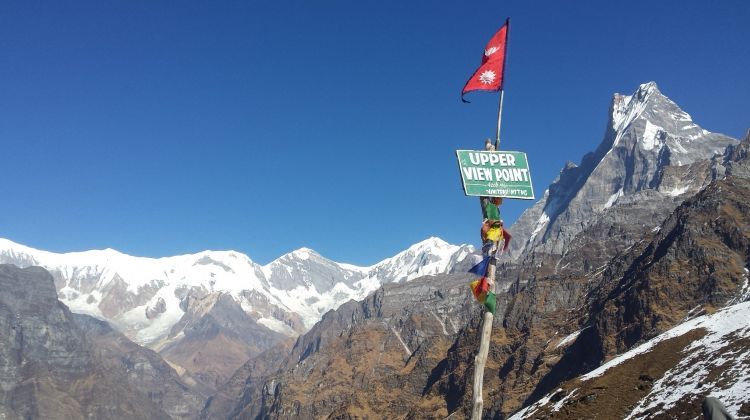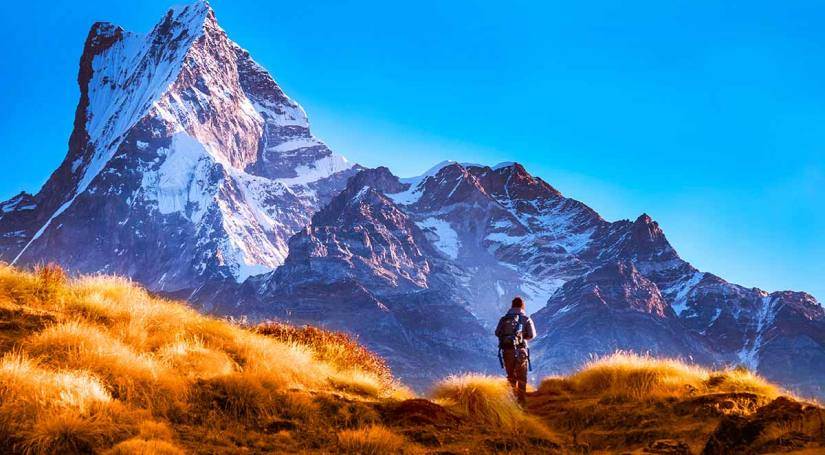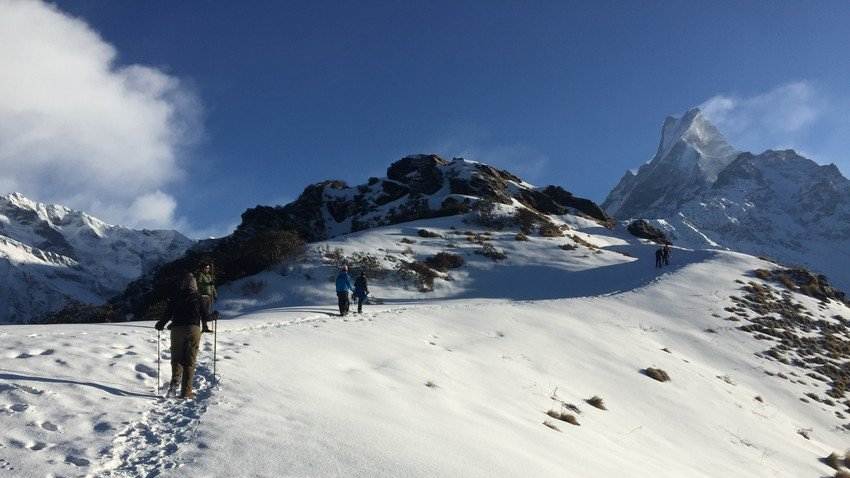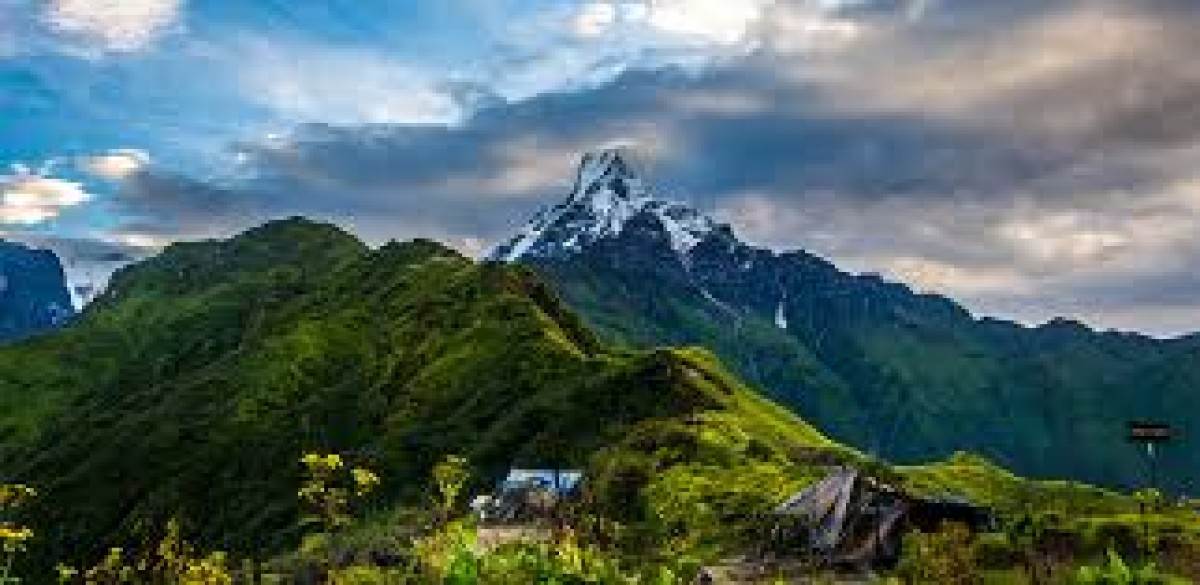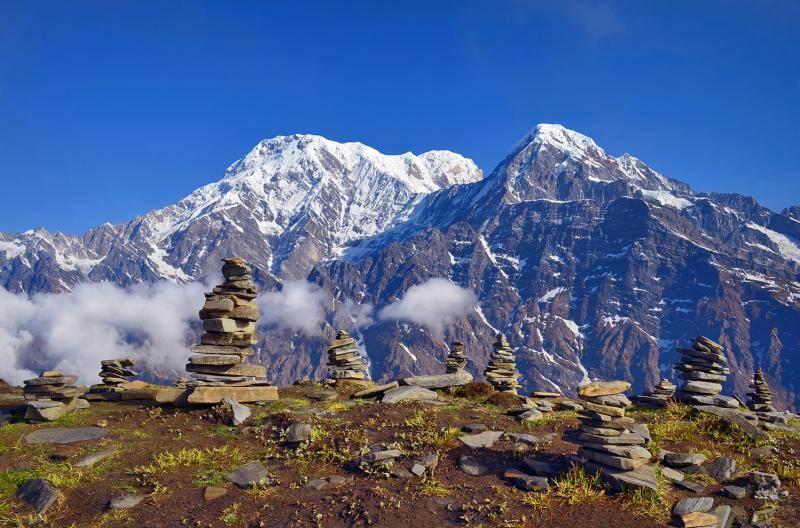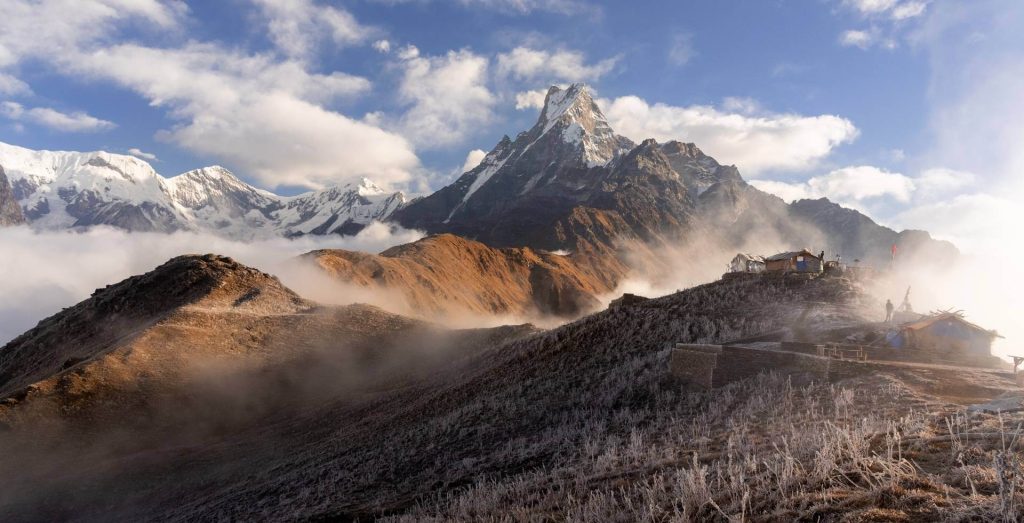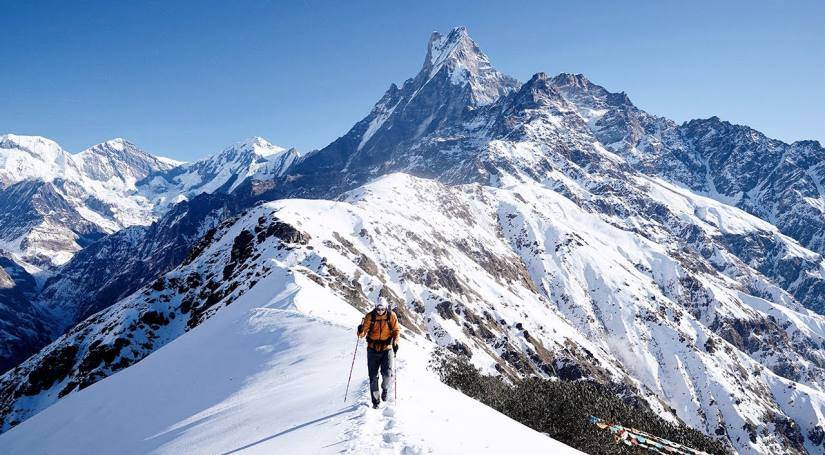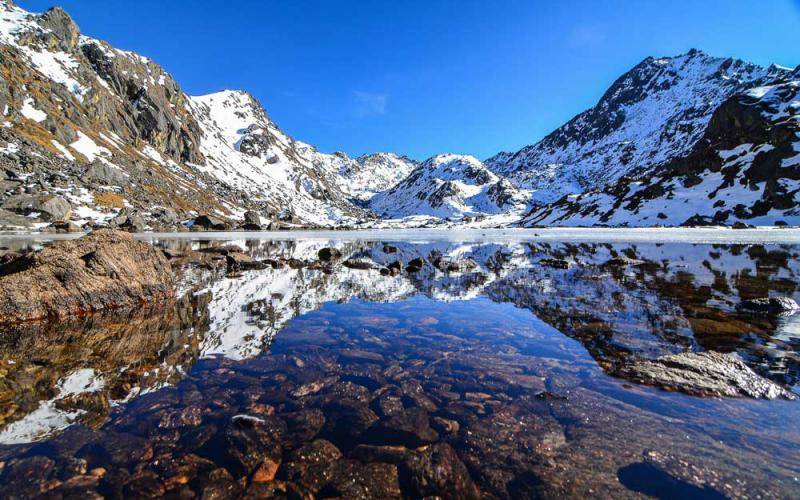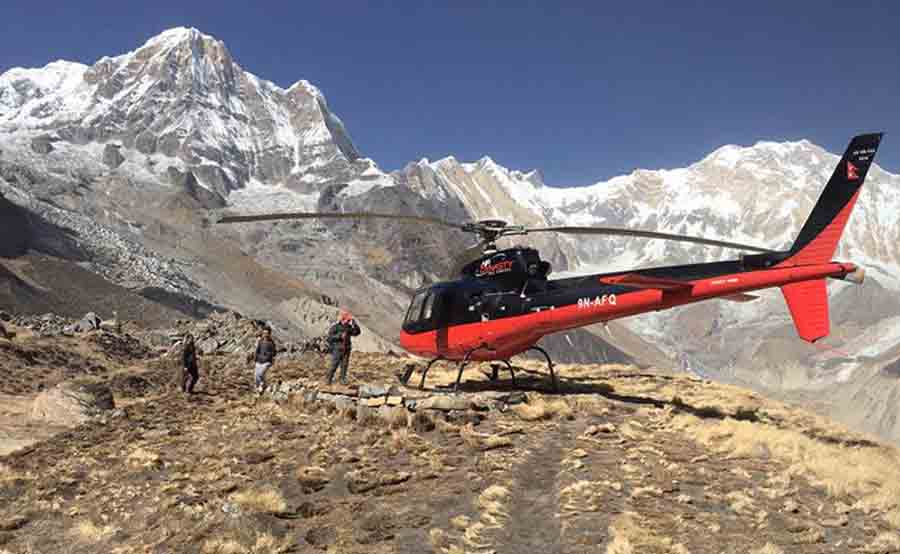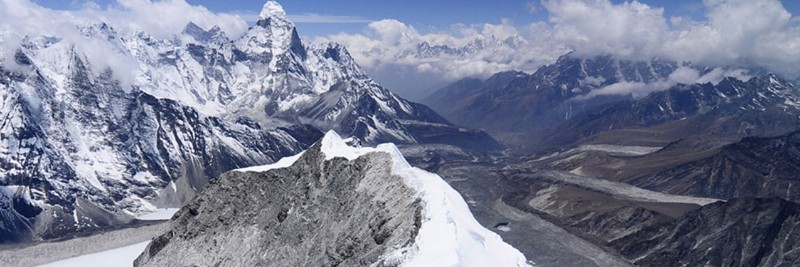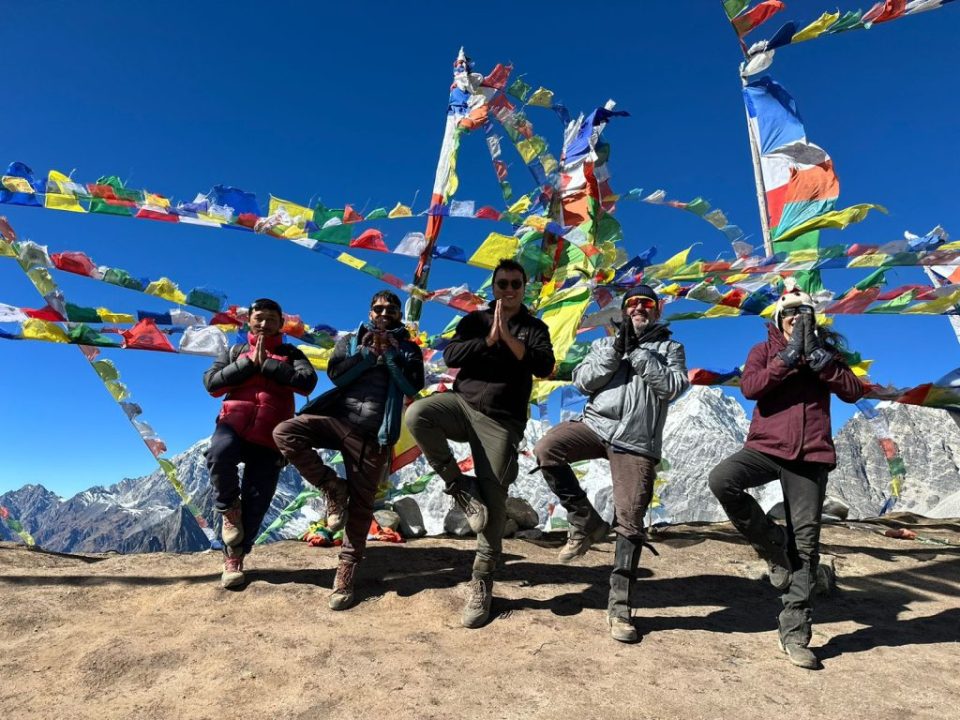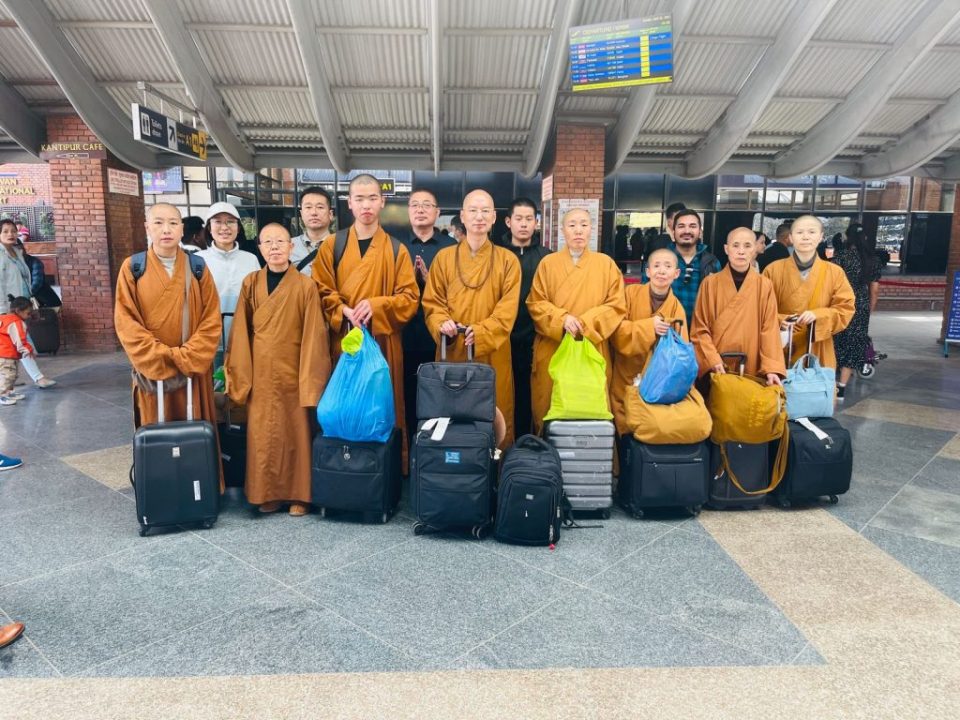Mardi Himal Trek
Destination
Mardi HimalMax Elevation
5440Fitness Level
Moderate to Adventurous walks.Group Size
1-16Start-End
KathmanduTrip Introduction
The Mardi Himal Trek provides a thrilling hillside trekking experience over a beautiful and unspoiled Himalayan path. The Mardi Himal Trek is located to the east of the Annapurna Base in the elevation of 4,500m/16,404ft, one of Nepal’s most renowned trekking destinations. The Mardi Himal Trek is a true treasure. Mardi Trek is a short and exciting trek that brings you to one of the Annapurna Region’s least travelled paths
The Mardi Himal Trek includes traveling along a narrow mountainside bordered by the stunning Annapurna Region and lush valleys. Views of the snowy mountains and valleys that are unobstructed and exposed. The Mardi Himal Trek is ideal for both beginner and experienced hikers seeking for a short and easy trek in the Annapurna area. The track passes through beautiful rhododendron trees. The scenery quickly turns into a rocky high mountain landscape with spectacular views of Mardi Himal, Machhapuchre, Annapurna South, and HiunChuli.
The nine-day adventure begins with a flight from Kathmandu to Pokhara. And then there’s the hour-long journey from Pokhara to Kande. Hike through beautiful rhododendron, pine, and birch forests. During the spring, rhododendron blossoms cover the forest, and following a route filled with pink and red blooms is a magical experience. This trek take you close to the Mardi Himal and other.
Trip Facts
| Country | Nepal |
| Region | Annapurna |
| Maximum Altitude | 4,500m/16,404ft |
| Duration | 8 Days |
| Grade | Moderate |
| Meals | Breakfast, Lunch, Dinner |
| Accommodation | Hotel, Lodge, Tea Houses |
| Best season | Mar, Apr, May, Sep, Oct, Nov |
Trip Highlights
- Trek along the less busy and freshly opened isolated trail.
- Enjoy the diverse flora and fauna as you walk across the trails.
- Take two wonderful Himalayan Mountain flights, between Kathmandu and Pokhara.
- Trek through a traditional mountain settlement, a beautiful green jungle, and incomparable natural scenery.
- Explore Local culture, traditional villages, and friendly welcome from the locals.
- Experience the View of the sunset over the fishtail from Mardi high camp.
Is this trek appropriate for you?
- The Mardi Himal Trek is the Moderate Trek. You can easily complete this trek if you are physically and mentally prepared and willing to do so.
- You will be Trekking for 5 Days. The Path can be Completed in as little as 2 hours as much as 8 hours.
- The walk is not tricky, there is no Climbing or Scrambling but the path is rocky and hilly.
- Each day you will cover 200 to 400 meters in height while trekking. The highest point in the trek you will reach on the trek is 4,500m.
- The weather and Remoteness of this trek, as well as dealing with the high altitude, require a slow pace and the need to stay hydrated.
Itinerary
| Days | Activities | Durations |
| Arrival at TIA Kathmandu (1,400m/4,592ft) | ||
| Fly to Pokhara and Hike to Australian Base Camp (2,400m/ 7,875ft) | 1-2 hrs | |
| Trek from Australian Base Camp to Forest Base Camp (2,600m/ 8,530ft) | 5-6 hrs | |
| Trek from Forest Camp to High Camp (3,580m/11,745ft) | 7-8 hrs | |
| Trek from High camp to Mardi Himal Base Camp (4,500m/ 16,404ft) and Back to High Camp | 7-8 hrs | |
| Trek from High Camp to Siding (1,885m/ 6,185ft) | 7-8 hrs | |
| Drive from Siding Village to Pokhara (800m/2,624ft) | 3hrs | |
| Fly Back to Kathmandu (1,400m/4,592ft) | ||
| Departure |
Itinerary
Departure from
Arrival On
Day 1
Arrival at TIA Kathmandu
Upon arrival at Kathmandu International Airport (TIA). Our agent will greet you and accompany you to the hotel. Drive to the hotel and check-in. Our guide will come to see you in the evening and give you a brief overview of the journey. At the hotel, we had dinner and stayed the night.
Day 2
Fly to Pokhara and Hike to Australian Base Camp
After enjoying your breakfast, your guide will assist you in checking out and transferring to the airport for your trip to Pokhara. The flight takes around 30 minutes, during which you will be exposed to a scenic view of Pokhara, a lovely lakeside city. After arriving in Pokhara, our staff and guide will be waiting for you with vehicle. Then you will have a drive for one-and-a-half-hour to Kande. From Kande you trek starts. We climb upward from Kande through the forest to Australian Camp.
A 2-hour hike will lead us to the lovely Australian Camp. Along the way, we may witness spectacular views of the Annapurna Range, including Machhapuchhre (Fishtail), Annapurna South, Hiuchuli, Annapurna II and IV, and Lamjung Himal, among others. Many twinkling stars can be seen sailing in the clear sky at night, resembling like a galaxy. Take a moment to capture the view. Dinner and Overnight at the Lodge.
Day 3
Trek from Australian Base Camp to Forest Base Camp
Make sure to wake of early and watch the colourful sunrise from either from the rooftop of the lodge or from the viewpoint of Australian Base camp.
Following breakfast in the morning, we will trek for almost 5 hours through the jungle to reach Forest camp, passing by Pothana village and Pritam Deurali. You’ll be eating lunch on Pritam Deurali. After filling our stomach with Nepali lunch and our eye with the sight of snow-capped mountains, we will make our way to the forest camp. Enter a beautiful wilderness filled with birch, huge rhododendron, mountain oak, maple, and hemlock trees. Trekking will provide spectacular mountain views if the weather is clear. Dinner and Overnight at the Lodge.
Day 4
Trek from Forest Camp to High Camp
After breakfast, it’s back uphill as you grab your belongings and make your way to High camp. Ascend a wooded path. From here, take in the sight of the Modi Khola Valley, which leads to the Annapurna Sanctuary. Lunch will be served at the Low camp. After lunch and some rest move toward Badal Danda.
For a while after walking, the vegetation begins to transform. The lush forest gives way to short scrub and grasses, and the famous Machhapuchhre becomes more visible. When you get in Badal Danda, have a short stop and take in the magnificent scenery as clouds that resemble cotton emerge nearby. Badal Danda to High camp is around 2-3 hours distant. The forest line disappears, revealing a stunning view of Machhapuchhre. As you approach the 3,000-meter point, walk gently. You walk over a hillside with spectacular views of Himalayan peaks and lush valleys. High camp is situated in the top of a hill, surrounded by the snow-capped mountains. Dinner and overnight at the Teahouse.
Day 5
Trek from High camp to Mardi Himal Base Camp
Early in the morning, have breakfast and set out on a trek to Upper Viewpoint. The true highlight of this trek is the of Mardi Himal Base camp. The Upper View Point is reached after another 20 to 25 minutes of trekking up the slope.
Continue on to Mardi Himal Base Camp from here. The majestic peaks of Annapurna South, Huinchuli, and Machhapuchhre look to be quite nearby. The peaks tower over you, and you can see enormous glaciers falling down the mountain slopes. The tallest peak, Annapurna I, lies beyond, and the surrounding landscape ranges from Dhaulagiri to Ganesh Himal. Leave for high camp on time after enjoying your lunch with a view of the Mardi Himal from basecamp. Dinner and Overnight at the Tea house.
Day 6
Trek from High Camp to Siding
After a peaceful breakfast at High camp, you will depart for Siding. Today we’ll go all the way down to Siding. We take the same path until we get to Low camp, then we take a different way to Siding. The descent can be difficult at times, with steep stone stairs and slippery ground. We travel through a deep forest, surrounded only by trees and shrubs. We’ll arrive at Siding after roughly 7 hours of steady descent. Dinner and Overnight at the Lodge.
Day 7
Drive from Siding Village to Pokhara
It’s a gorgeous morning in Siding. There are brightly coloured flowers all around, and the landscapes appear to be alive. Pokhara is our destination for today. A Vehicle will be waiting for you to take you to Pokhara, the city of lake. On arrival, check into your hotel, get fresh up and have some rest. Evening you can walk around Lake side Pokhara, or go cycling. Dinner and an overnight stay at the hotel.
Day 8
Fly Back to Kathmandu
After breakfast, you can go sightseeing in Pokhara or try paragliding. After that, have lunch and then fly back to Kathmandu. The flight lasts approximately 30 minutes. You will be escorted to the hotel and assisted with check-in. After a while, take a break or go shopping if you want. You can wander around Thamel. After that, you’ll enjoy a farewell dinner with your teammates. Dinner and Overnight at the Hotel.
Day 9
Day 09: Trek to Lumre, drive to Pokhara and drive back to Kathmandu
From here, we trek for 2-3 hours to reach Lumre. Here, we get access to transportation and drive back to Kathmandu or drive to Pokhara. From Pokhara, we take a 25-minute flight back to Kathmandu. We explore the tourist hubs of Kathmandu in the evening.
Day 10
Day 10: Final departure
We bid you farewell at the airport and welcome you to visit Nepal again.
Route Map
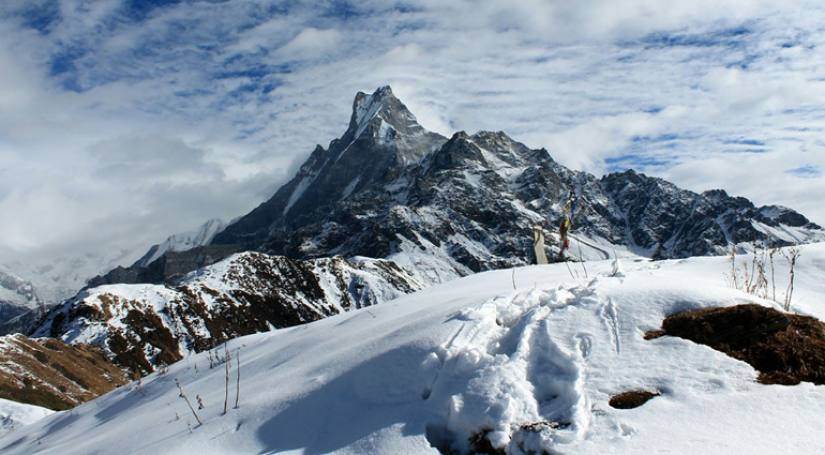
Altitude Map
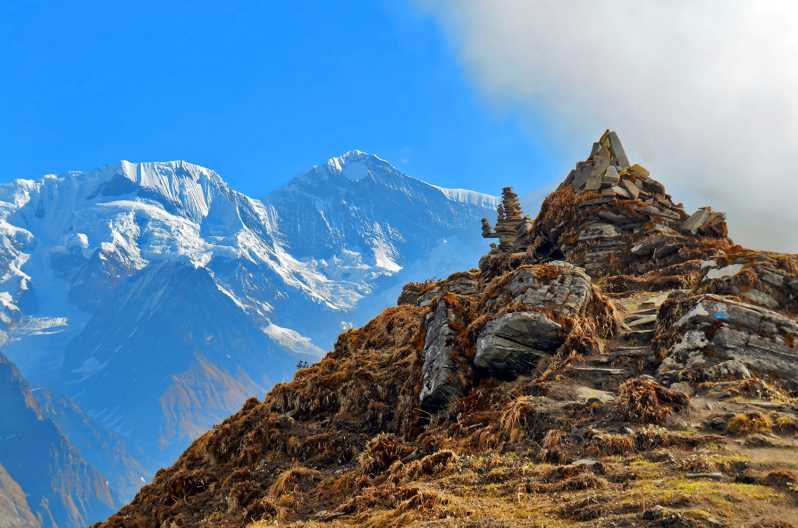
What's Included
- Arrival and Departure: Airport – Hotel – Airport (Pick Up and Drop).
- Hotel Accommodation in Kathmandu: 2 nights in a star category hotel on a BB basis for twin sharing.
- Hotel Accommodation in Pokhara: 1 night in a star category hotel on a BB basis for twin sharing.
- Welcome Dinner and farewell dinner at Nepali culture restaurant in Kathmandu.
- Food & Lodging: 3 meals a day (Breakfast, Lunch, Dinner) along with accessible accommodation sharing during the trek.
- Permit: All required documents: ACAP Permit and the TIMS card charge.
- All government and local taxes if necessary.
- Member transportation: – Air Transportation: (Domestic Flight) Fly from Kathmandu – Pokhara and while returning Pokhara.
- Road Transportation: Drive from Pokhara – Kande and Siding to Pokhara.
- Drinking: 2 liters of boiled water to carry on thermos per day per member.
- Guide: Government licensed Guide (English speaking) during the trek
- Porter: Porters (2 trekkers: 1 porter) up to 15kg during the trek.
- Insurance of guides and potters.
- Comprehensive Medical kit.
What's Not Included
- Air Fare: International flight airfare (from and to Kathmandu).
- Nepal entry visa fee.
- Extra night in Kathmandu: Extra nights’ expenses in Kathmandu. In case of early arrival or late departure, early return from Trekking (due to any reason) than the scheduled itinerary.
- Personal Insurance: Travel and high-altitude insurance. *Mandatory
- Personal Expenses: Telephone calls, Internet, Toiletries, battery recharge, hot shower, laundry, soft drinks, beer, and any alcoholic beverages.
- Personal Equipment: Clothing, Packing Items or Bags, Personal Medical Kit, Personal Trekking equipment.
- Rescue Evacuation: Medical and emergency rescue evacuation costs if required. (Rescue, Repatriation, Helicopter, Medication, Medical Tests and Hospitalization costs).
Equipment List
What to bring ?
General
Fixed Departure
Why Travel With Us?
Secure Online Payment, No Credit Card Fee
Travel with Locals. Support Locals
Lifetime Deposit
Private & Tailor-Made Trips
24/7 International Support
Support Local Communities & Donate to Charity
All Inclusive Price
Secure Online Payment, No Credit Card Fee
The ideal season to travel
January:
In Nepal, January is in the midst of winter. The higher elevation receives moderate snowfall, whereas the lower elevation is ideal for trekking. Early January is likely to be one of the best times to visit the Annapurna Region. Annapurna Region trekking in January provides some of the best mountain views. The trail will be covered with snow at higher altitudes. During the day, you will feel warm, but as night falls, you will feel cold. In January, these areas receive little to no rainfall. As a result, the skies remain clear and the surroundings appear even sharper.
February:
The Annapurna Region trek in February is an escape from the hustle and bustle of everyday life to a place where all you can see are mountains and scenery. It’s peaceful because February is the coldest month of the year. Most people dislike trekking in the winter because they believe it is extremely difficult. The whole trail will be covered with snow, making the walk difficult with crampons.
March:
The month of March is ideal for trekking and admiring the spectacular mountain peaks. The trekking trail will be crowded with hikers beginning in March. In the Annapurna region, the spring season begins in March, the month of the Rhododendron. Trekking in March will provide you with the most memorable experiences in a pleasant and mild climate.
April:
April is the beginning of spring in Nepal, and the weather is ideal for trekking to Annapurna Region. The views are bright and clear at this time of year, and everyone enjoys spring. The surroundings are vibrant and colorful, with rhododendrons in bloom. It is the best time of year to see various bird and butterfly species. During your April trip to ABC, the weather is completely in your favor. The moderate heat of the sun, combined with the lack of wind, makes it ideal for trekking. Furthermore, the amount of rain and snow is insignificant.
May:
May, the final month of the Spring season in Nepal, is much hotter. The Annapurna Region trek in May has the highest temperature of the year. Temperature and weather will vary depending on the altitude throughout the trek. At lower altitudes, daytime temperatures can reach 20°C. At night, the temperature drops to around 5°C. During the day, the weather in the lower sections will be extremely hot. The nights, on the other hand, are tolerable.
June:
June is the coldest time of the summer and has the least amount of rainfall. In June, the Annapurna Region has a minimum temperature of 0 degrees Celsius. The month of June is the offseason and therefore less popular for trekking. In the region, June marks the start of the wet monsoon season.
July:
Trekking in Nepal in July isn’t always joyful because the heavy rains can block your view of the beautiful mountains you’ll pass through. In July, you will notice that the temperature is not as chilly in the Annapurna Region. During the month, the lowest temperature is 6 degrees Celsius and the maximum temperature is 18 degrees Celsius.
August:
In the Annapurna region, August is the off-season for trekking. In August, the monsoon season produces strong rains, especially in lower places. Due to weather-related concerns, most hikers avoid this month. The summer monsoon season comes to an end in August. It rains regularly, and you may feel a little chilly as a result. You should also be cautious because the trails are slippery and the possibility of landslides and avalanches is considerable. In addition, the temperature on the trails remains between 6 and 18 degrees Celsius.
September:
The monsoon season finishes in September, marking the start of the fall season. The optimum time to trek to Mardi Himal Trek is in September. The weather and temperature for the Mardi Himal Trek are ideal. The temperature is pleasant during the day, but it is extremely chilly at night. The temperature drops 0 degrees or below zero degrees at night.
October:
October is the month that falls between September and November. As a result, it keeps both monsoon rain and winter’s biting cold at distance. The weather is warm and pleasant in October, with clear skies and fresh air. The nights, on the other hand, are a little chilly, with a brisk breeze coming from the campsite. Throughout October, the weather is pleasant, allowing people to enjoy an unobstructed view of the snow-capped peaks. They can also visit bright valleys and interesting scenery of various colors.
November:
The last declared peak season for trekking in Nepal is November. Bright, sunny days and beautiful skies characterize November. On the treks, these provide breathtaking, crystal-clear vistas of the mountains. The days are bright and sunny in November. The sky is clear, with perhaps a few stray clouds possible. The weather is cold, ranging from 12 to 17 degrees Celsius. The average temperature lowers to 7 degrees Celsius at night.
December:
In the Annapurna region, December is a rather dry month. It receives fewer than 25 millimeters of rain every year. The Annapurna region is in the shadow of the Himalayas. As a result, December has a lower chance of rain. It is also possible to walk the Mardi Himal Trek in December. In December, hikers will get a unique perspective of the region.
Flight to Pokhara
- You can book tickets online as well as through any travel agency.
- Trekking to Ghorepani Poon hill is one of the most exciting adventures you can have. Almost every journey begins with a flight from Kathmandu to Pokhara Airport, in the beautiful lakeside city of Pokhara. It lies 200 kilometers from Kathmandu, at an elevation of 2711 feet.
- The Kathmandu Pokhara flight allows for 20kg of checked bags and 5kg of hand luggage.
- Every day, a large number of flights depart from Tribhuvan Airport’s domestic terminal, taking only about 30 minutes. It’s a beautiful flight, especially if you seat on the right side of the plane and look out the window towards the Himalayas.
Altitude sickness
Though the Annapurna Region Trek is one of the most cherished and sought-after treks on nearly every trekker’s travel list. Most of all the trek in the Annapurna region is located beyond the altitude of 2,500m and altitude sickness is the sneaky monster that sometimes attacks even the fittest trekkers beyond 2500m (8,000ft).
As a result, preventing altitude sickness on the Annapurna Region trek and remaining healthy throughout the trek should be your top priorities. With lower air pressure and lower inspiratory oxygen pressure, you’ll be hiking into the high-altitude zone. Acclimatization is the process of progressively becoming familiar with the new climate or changing environmental conditions. Almost everyone going quickly from lower to higher elevations requires altitude adaptation.
At elevations beyond 2,500 meters, AMS symptoms can be detected like:
- Increased breathing.
- Increased urination.
- Restless sleep.
- Periodic breathing at night because of altitude.
- Shortness of breath.
- Extreme fatigue.
- Respiratory failure.
- Cerebral edema.
To guarantee that the condition does not worse, certain precautions should be taken. However, if the symptoms increase, it may be necessary to return to a lower height and seek medical assistance.
- Walk slowly and gradually, as our bodies require time to adjust to the oxygen level. At least one day of acclimatization rest is required for high altitude trekking, and you should go as high as possible before returning to a lower height for the night.
- To gain strength stamina for your Mardi Himal Base Camp journey, you should undertake various strength training exercises such as running, cycling, jogging, push-ups and going to the gym.
- The greatest remedy is to always stay hydrated. On your walk, instead of drinking cooled water, drink warm water and avoid alcohol, cigarette, and tobacco. You should also eat a balanced diet for strength.
- Before traveling to an altitude greater than 2000 m, you must properly acclimate. If your body displays any signs of altitude sickness, you must either stop immediately where you are or consider descending to a lower altitude.
- Bring a Diamox subscription with you on the trek because it is the most effective altitude sickness medication. However, you should consult with your doctor to see whether it is beneficial.
Things to know before travelling to Mardi Base camp.
Drinking-Water
Especially for trekkers, it is very necessary to hydrate your body at a higher altitude than in lower elevations to avoid dehydration and altitude sickness. Lack of fluid can be the main hindrance during the trek. You should hydrate your body with at least 3-4 liters of water daily (Tea, soup, or normal drinking water).
Annapurna region does not have a water shortage. You can get tap water, spring water throughout the trek but it is not safe to drink without purifying it. Also, the sale of plastic water bottles is banned in Annapurna Region since 2015. You will not get to buy plastic water bottles throughout the trek. Therefore, you need to bring your water bottle. We recommend you use a Reusable water bottle or water pouch favorable for both hot and cold water. You can also use a filtration system like LifeStraw.
Here are some ways that you can use to make the water drinkable.
- Boiled water
Boiling water is the best way to purify the water. As we are climbing to a higher altitude you need to boil the water for about 3-minute and season it with a pinch of salt before drinking. You can get free cold water in the teahouse but for boiled water, it cost around 1-1.5USD per liter.
- Purification tablets or electrolyte powder.
Purification tablets like chlorine or iodine tablets are commonly used tablets by trekkers to disinfect the water. 1 tablet is enough for a liter of water. It takes around 30 min for the tablets to dissolve and become drinkable. Water, purified by tablets may leave a taste in your mouth.
Electrolyte powder is another option. Electrolyte powder is a better way to purify water than tablets because electrolyte powder contains minerals such as salt, Potassium, Magnesium, which are important for your body during the trek.
- UV Light water purifier/ SteriPEN.
It is a simple, effective, economic, and environment-friendly way to purify water. It kills the bacteria and virus within 10 sec by exposing them to ultraviolet light using Steripen, without changing the flavor of the water. This is a highly recommended method of purifying water.
Essential Backpack items for Mardi Trek.
The bag of a trekker also reveals the trekker’s level of experience. A good trekker should be a smart backpacker. You should be pre-prepared for the things that you need in the trek.
Here are some of the things that you need to take with you for the trek.
Travel documents
- Airline tickets with the itinerary.
- Travel insurance policy documents.
- Valid passport.
- Copies of passport.
- Passport-sized photos.
- Nepalese cash.
- Travel permits.
Clothing
- A pair of waterproof trekking shoes or hiking boots.
- A pair of flip flop slippers or running shoes.
- 2 sets of thermals (leggings and tops)
- 2-3 pairs of hiking long sleeve shirts or tops.
- Pairs of hiking shorts and pants.
- Fleece jumpers or a set of tracksuits.
- Good quality windproof down jacket.
- Lightweight waterproof rain jacket and pants.
- Neck gaiter, leg warmer, and packet of pocket hand warmers.
- 4-5 pairs of quick-dry socks, underwear, sports bra.
- Pair of inner and outer gloves.
- Knitted Hat, sun cap, beanie, or bandana.
- Glacier Sunglasses and eyeshade.
Trekking equipment
- Waterproof trekking bag of 40-50 liter and Rucksack of duffel bag (if your backpack is not enough for all your item and need a potter).
- Reusable water bottle (both hot and cold) of at least 1-2litre.
- A sleeping bag and sleeping bag liner.
- Trekking stick/ poles
- Crampons (If you are trekking in the Winter season, Jan-Feb).
- LED Headtorch or solar lamp (LuminAID Nepal lamp is best as it is solar-charged and very much portable)
- Plug adapter, Charging appliances, power bank, batteries.
- Pocket knife.
- Travel Wallet.
Toiletries
- Rolls of Toilet paper, wet wipes, and tissue.
- Medium-sized quick-drying towel.
- Toothbrush and toothpaste.
- Hand sanitizer.
- Sunscreen, lip balm, body lotions.
- Portable mirror.
- Shampoo and soap.
Personal First Aid Kit
- Antibiotics
- Painkillers, Paracetamol, ibuprofen, aspirin, Nicole
- Sanitary pads
- Anti-inflammatory spray.
- Anti-Nausea tablets.
- Anti-diarrhea pills or power.
- Altitude sickness tablets.
- Water purifying tablets or electrolyte powder.
- Mosquito and Insect Repellent.
- Salt or anti-leech oil (If traveling in the rainy season, July- Aug).
- Earplugs
You can buy or hire trekking clothes and equipment in Kathmandu. If you are buying it, you have to allow an extra day for shopping; however, if you are hiring it, you must inform us in advance so that we can arrange it before you arrive in Kathmandu. This way you can reduce the weight of your luggage and save time and money.
Branded trekking clothes and equipment are available around the Thamel area at a reasonable price.
Note- Kathmandu- Pokhara flight has a luggage allowance of a maximum of 20 kg per person. For extra baggage, they charge 1$ per kg. So, you can wear your trekking boots and jacket to reduce the weight. Have a hand carry bag for your passport, money, medicine, and a pair of clothing. And you can also leave your unnecessary items in the Kathmandu hotel.
Accommodation, Meal, and Transportation
Accommodation
We will accommodate in star hotel during our stay in Kathmandu.
In the Australian Base camp, we will stay in lodges.
For the rest of the stop, we stay at teahouses.
Meal
During the trek, we will provide you three-time meals. You can choose from the given menu.
Breakfast– French toast, Cornflakes, Cereal, Pancakes, Bread butter, Eggs, Oatmeal, Porridge, Tea, etc.
Lunch– Dal Bhat set (Rice, Vegetable curry, Meat curry, Lentils, Tomato Chutney, Salad, Papad) Vegetable noodle soup, Chicken noodles soup, Mushroom garlic soup, Fried noodles, Mo: Mo, Fried cheese Potato, etc.
Dinner– Dal Bhat set (Rice, Vegetable curry, Meat curry, Lentils, Tomato Chutney, Salad, Papad), Mo: Mo, Fried noodles, Spaghetti, Thukpa, Pizza, Stews, Fried Potato, etc.
Besides these, there are a variety of other options of food. You can buy it from your pocket.
Transportation
By Bus- From Kathmandu airport to Hotel at Kathmandu and vice-versa.
From Pokhara airport to Kande.
From Siding to Pokhara Hotel.
From Hotel to Pokhara Airport.
By Air- Flight to Nepal.
Flight from Kathmandu to Pokhara and back.
Guide and Staff Arrangements
Our well-qualified and professional staff will handle all your activities throughout your trek. They will do all the escorting. We are providing you with a highly experienced and licensed guide with fluent English speaking and has excellent communication as well as navigation skills. They will accompany you from Pokhara Airport and guide you to Mardi Himal Base camp. Each group of 4-5 trekkers will be assigned an assistant guide, as well as a porter for two trekkers (2*15kg =30kg). If your luggage weighs more than 15kg you will be provided a porter individually but you will be charged for 2 people.
All our lead guides, assistant guides, and potters are well professional and experienced. So, we hope for your respect and cooperation with them
A typical day on the Mardi Trek.
Every day will begin with the ringing of your alarm clock at 6 a.m. and a knock on your door from your guide with the invitation of breakfast. Get up, have breakfast, pack your backpack and get ready to start your day’s walk by 7 a.m.
You will walk through the lush forests of Rhododendron and Oaks, enjoying the scenery, crossing numerous suspension bridges, clicking photos, creating memories, passing by other travelers, interacting with your guide, hearing each other’s stories.
Lunch will be served at a local teahouse in the late afternoon (1-2 am). Having lunch and an hour of rest, we will proceed to the day’s final destination as per the itinerary.
On arrival at the destination, check in at your accommodation. Get freshen up and some rest. As every teahouse where we stay has a large common dining area with a wood-burning stove in the center, there you will get to meet many travelers. You can sit there, laugh at each other stories, play cards, sing songs, play music, and have a good time. This will help you forget all the tiredness of the day. Later in the evening, you will have your dinner together. Enjoy the flavorful Nepalese Dal Bhat. There is this saying Dal Bhat power 24 hr. After dinner, your guide will give some short briefings about the next day’s trek regarding when you must get up, when we have to start our trek the next day, where we will stay the next day, how many hours we have to walk and so on.
During this trek, you’ll walk for a minimum of 2 hrs to a maximum of 8 hrs per day. You will get to experience a glimpse of Gurung culture, their authentic village lifestyle. At night enjoy the view of twinkling stars floating in the clear sky above the cold wind. During this trek, you will get to see the 10th highest mountain of the world Mt Annapurna, a Scared and unclimbed mountain -Mt. Machhapuchre, Mardi Himal, lush forest of Rhododendrons and Oaks.
Every stop during this trek offers you a majestic view. Your hard walk will be paid off on reaching the destination.
Nepal Tourist Visa and permits details
Visa procedure.
To travel to Nepal, you’ll need a tourist visa that is valid for the period of your stay in Nepal. Better, if you have a tourist visa valid for at least 2 months because anything can happen during the trip, and staying in Nepal after your visa expires would result in you paying a penalty. Apply for a visa at your nearest Embassy of Nepal or obtain an On-Arrival visa at immigration in Tribhuvan International Airport, Kathmandu. But it’s better to contact your nearest Nepalese Embassy.
Here are the documents that you need, to apply for the tourist visa.
- The Tourist Visa Application Form for Nepal (Fully completed online and printed)
- Original Passport with at least 2 blank pages and validity of at least 6 months.
- Photocopies of your passport’s information page.
- At least 2 recent passport-sized photos of yourself with white background.
- Proof of accommodation in Nepal.
- Valid travel and return flight tickets.
- A bank statement from the last 3 months with a minimum closing balance of NPR2,00,000.
- Receipt of the visa fee for Nepal.
Note: Our trip is for 10 days. 15 days tourist visa costs USD 30 or if you want to extend your stay in Nepal apply for 30 days tourist visa that costs USD 50.
Entry permits and Requirements
Annapurna Region is a Conservation Area. To travel over the Annapurna region, the trekkers need to get permits from the Government of Nepal. The entry permits that you need for the Mardi Himal base camp trek are-
| Trekking permits | Foreign Nationals | SAARC nationals | Nepali Citizens | |
| 1 | Annapurna Conservation Area Project permit.
(ACAP entry permit) |
NPR 3,000 per person per entry | NPR 1,000 per person per entry | NPR 100 per person per entry |
| 2 | Tourist Information Management System card.
(TIMS Card) |
NPR 1,000 per person with a guide (GT) and NPR 2,000 for solo trekkers (FIT) | NPR 300 per person with a guide (GT) and NPR 600 for solo trekkers (FIT) | N/A |
Note: You can get both the Annapurna Conservation Area Project Permit and TIMS Card from Nepal Tourism Board in Bhirkuti Mandap, Kathmandu, or Tourist Information Centre in Pokhara.
For the issue of the TIMS Card, you need at least 2 members, accompanied by a licensed guide.
For more information about TIMS Card here is the link.
(If you are traveling from a travel agency your agency will arrange all the Permits.)
Documents required to get these permits.
- Complete the permit form with your passport details and tour details (Trekking area, Entry and Exit date, and point, Route of Trekking, Emergency contact information for Nepal and your Home country).
- Passport size photos.
- Photocopies of passport personal information page.
- Copy of Travel Insurance policy to obtain TIMS card.
Travel Insurance
During the journey, you may encounter several unexpected incidents or losses. Trekking in Nepal is an adventurous and occasionally dangerous activity, especially at high altitudes. Trekkers must have travel insurance before visiting Nepal for trekking.
You might come across some physical injury, illness, unexpected accident during the trek and all the medical expenses and loss has to be borne by yourself.
As we will be trekking up to Mardi Himal Base Camp (4,500m), you need to choose an insurance policy that will cover all the possible risks that you may come across from the start of your journey to your final destination. The following threats should be covered by your travel insurance. The following threats should be covered by your travel insurance:
- Cancellation of Domestic and International flights.
- Lost and stolen baggage and passport.
- Hospital and Medical expenses (Physical injury, Acute Mountain sickness, Altitude sickness, sudden accident)
- Emergency rescue such as Helicopter.
- All high-altitude trek risk factors up to 4,500m.
You need to choose your travel insurance wisely so that, in the case of such an incident, your travel insurance will cover the costs.
You can get your travel insurance in either your home country or in Nepal.
Responsible Travel
Annapurna region is a region with numerous trekking trails. Annapurna region is the most popular trekking region in Nepal. This region is also known for its typical Gurung culture and Gurung villages. Throughout the trek, you will encounter many traditional villages inhabited by the Gurung and Magar. All travelers should travel responsibly in these regions. You must respect the local people, their culture, religion and try to limit any negative activities that will impact their local culture and environment. As Plastic water bottles is banned in the Annapurna region in 2015, we expect you not to bring any plastic wastage and properly dispose of the plastic garbage (food warmers, plastic water bottles). You might encounter rare species on the way to Annapurna Base Camp, you rather not disturbed them. You can support them by adapting yourself to their lifestyle.
Your responsible travel will help Nepal achieve long-term sustainable tourism.
Electricity and Internet facility at Mardi.
Electricity facility.
Despite the challenging geography and weather conditions, the Annapurna region has been providing electricity and access to the Internet.
Electricity in Annapurna Region is powered by hydroelectricity but at higher altitude, some teahouse relies on solar power. You can get free access to electricity throughout the trek. At lower altitudes, all the hotel’s rooms have charging sockets, but at higher altitudes, there is a commonplace for charging usually in the dining area, and you will be charged extra for the use of electricity for charging device on a different basis (Per device and voltage of your device).
Charging mobile phone costs 1.5$- 2$ per device.
Internet Facility and Service
Internet and network facility is must need to contact your family, friends, employee, to post updates and upload photos during the trek.
Internet access is available throughout the Annapurna Region, but in some areas, WI-FI might become slow due to the lack of reach of signal to tower and difficult topography.
At higher altitudes also, there is access to the internet, but have to pay extra to use their Wi-Fi hotspot.
Cost of WI-FI service in higher altitude- NPR 300/USD 2.5
Both NTC and NCell cellular service has been providing the network in Annapurna Region. You can buy the NCell or NTC sim card from the stores in Kathmandu for 1USD. By taking data packages you can use the internet service up to Mardi Base Camp.
NTC cellular service is most preferred over NCell. NTC provides good service and signals connectivity throughout the Annapurna region, in comparison to NCell.
| Buy NTC data package
Dial*1415# |
Cost of data package in NTC:
-14GB=7$ (Valid up to 28days -30GB=15$ (Valid up to 90 days) |
Check balance
Dial *1415# |
| Buy NCell data package
Dial *17123# and select. |
Cost of data package in NCell:
-15GB=10$ -25GB= 12$ (Valid up to 30 days) |
Check balance
Dial*101# |
Document needed to buy a sim card.
For foreigner = 1 passport size photo, Passport photocopy, or valid identity card.
For Nepali = 1 Passport size Photo, Photocopy of Citizenship.
Some useful tips to reduce the use of electricity.
- Extra batteries for the camera.
- Power bank with 5000-10000mAh.
- The solar charger and solar lamp (LuminAID lamp).
- As possible less usage of a device with low brightness, GPS, and WI-FI off.
FAQs
How much time should I spend on the path each day?
It depends on the person’s walking pace, but you should walk for at least 3 hours and no more than 8 hours per day.
How much money should I spend per day on trial?
You will spend a minimum of USD 30 to 50 per day, including your accommodation and three meals. If you travel with us, your package includes accommodation and three meals per day. As a result, you should consider your expenses such as beverages, snacks, and hot water, as well as charges, Wi-Fi, and so on.
What permits are needed while trekking in Annapurna Region?
- Annapurna Conservation Area Project permit (ACAP entry permit)
- Tourist Information Management System card (TIMS Card)
How is the Drinking water facility in Mardi Himal Trek?
Drinking water is not safe, so you should purify or boil it before drinking it, or you can purchase mineral water at a cost.
How are the Tea Houses in Annapurna Region?
Tea houses have excellent facilities because they offer a wide variety of food items on their menu. The rooms are spacious, with two beds and blankets. They have a western toilet and hot water for showers.
What should we avoid while trekking in Annapurna Region?
You should not disturb wildlife while trekking and should walk quietly; you should not listen to music while passing through the forest. It is best not to drink alcohol while trekking.
Mardi Himal Trek
Trip Reviews
Lorem ipsum dolor sit amet, consectetur adipisicing elit, sed do eiusmod tempor


